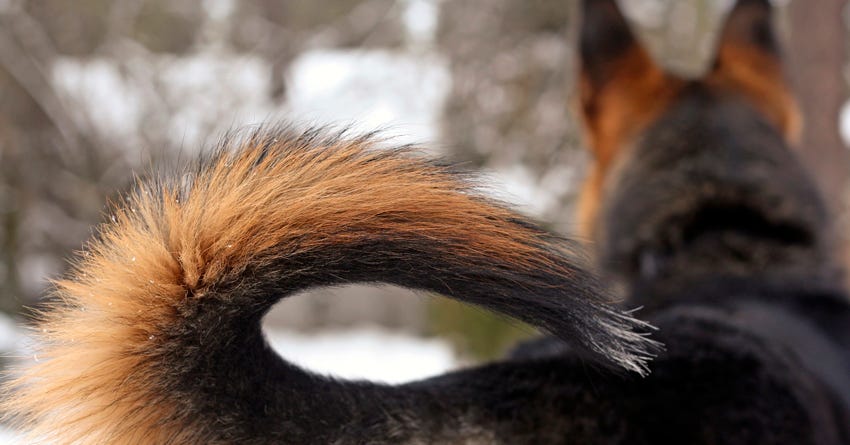6 Fun Facts about Your Dog's Tail

After having Australian Shepherds with docked tails for many years, I wasn't used to dogs with full tails when I brought home Bones, my English Shepherd.
Bones' tail is long and lush, and he uses it so well to express himself I found myself mesmerized. That fascination led to watching him use it as he runs; it makes a great counter-balance. Then I began paying more attention to my Aussies with their lack of a tail. How do they cope? Is there a difference between dogs with tails and without?The Tail is Attached to Your Dog
As we all know, the tail is at the posterior end of the vertebral column, the end of the backbone. There are generally between six and 23 vertebrae in a canine tail if the tail isn't docked, which we'll talk about later. These vertebrae are wrapped in flexible muscles that make side to side, up and down, and even circular movements easy. Tails vary widely from the long, sweeping German Shepherd tail to the curled, short Pug's tail. A Greyhound has a long thin whip-like tail while a Labrador Retriever has a medium length, thick, otter-like tail. The American Eskimo carries his tail high over his back, curled, while the Border Collie usually carries his tail lower. The variations in tails are just as different as the breeds themselves are.Communication is Key
The most visible function of the canine tail is communication. We know our dog's smiling face, wiggling body and happily wagging tail expresses joy. The tail by itself is not the communication, though, but instead, facial expressions, body movement, body position and the tail's motion all work together to communicate the dog's feelings. Although the tail is only a part of the dog's communication, it can definitely add some flair. The speed that the tail wags, the position up and down, and where the tail is carried all convey the dog's emotions. A worried dog will carry his tail lower while a fearful dog may tuck his tail tightly to his hips and between his back legs. An alert, confident dog will carry his tail higher but will usually hold it still while checking out something of interest. Most dogs use their tail to communicate in a similar manner, but each dog has his own individual accent. Some dogs are more reserved and don't move or wag the tail as exuberantly; think of a dignified German Shepherd greeting someone other than his owner. Other dogs are more enthusiastic; think of a happy Golden Retriever. Dogs with naturally short or docked tails can still wag their shortened nubbins of a tail, but they tend to use more body language so their message is still seen. Australian Shepherds, for example, wiggle the entire back half of the body when happy. Aussie owners call it the Aussie wiggle butt.The Counter-Balance Tail
Athletic dogs with a tail use it as a counter-balance when running, leaping and turning. The strong muscles in the hips, pelvis and tail all work together to move the tail as needed to keep the dog balanced as he's moving. If you watch a dog running and jumping to catch a ball, you may see him abruptly move his tail from one position to another. This is to help him balance himself as he's jumping or landing. Dogs with short or docked tails can still be balanced, especially if they have had a short tail since puppyhood. These dogs have grown up using the body they have. However, if a dog injures his tail in adulthood and loses part or all of the tail, his athletic skills change; his balance will be different. He can re-learn those skills but it does take some time. ©istockphoto/yangchao
©istockphoto/yangchao